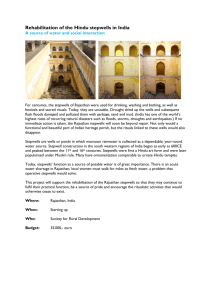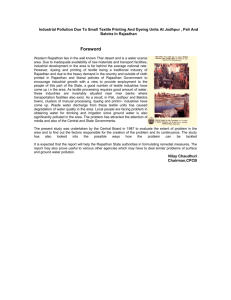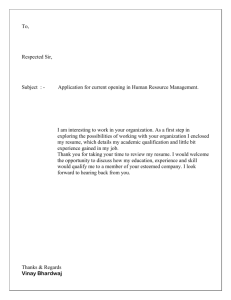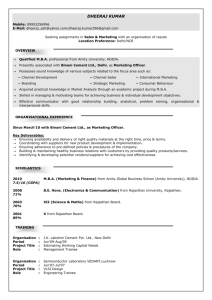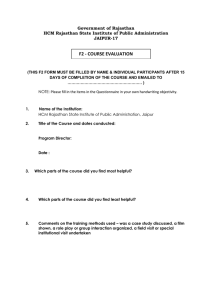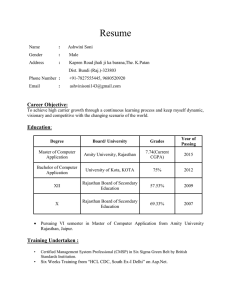State Update: Government of Rajasthan s
advertisement
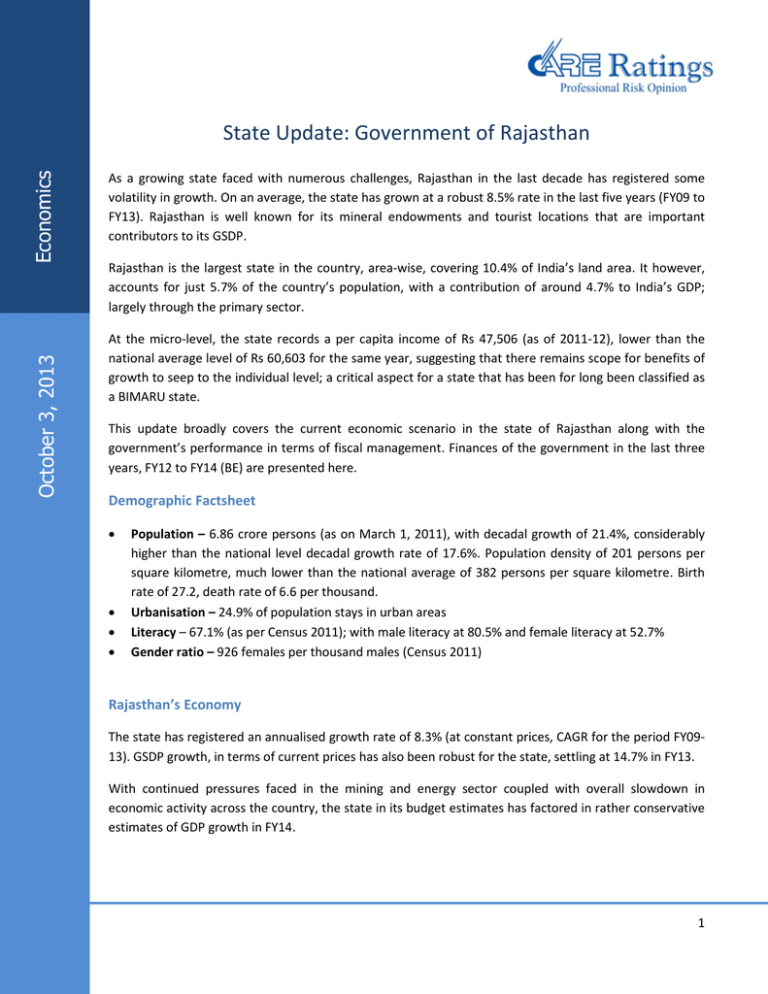
October 3, 2013 Economics State Update: Government of Rajasthan As a growing state faced with numerous challenges, Rajasthan in the last decade has registered some volatility in growth. On an average, the state has grown at a robust 8.5% rate in the last five years (FY09 to FY13). Rajasthan is well known for its mineral endowments and tourist locations that are important contributors to its GSDP. Rajasthan is the largest state in the country, area-wise, covering 10.4% of India’s land area. It however, accounts for just 5.7% of the country’s population, with a contribution of around 4.7% to India’s GDP; largely through the primary sector. At the micro-level, the state records a per capita income of Rs 47,506 (as of 2011-12), lower than the national average level of Rs 60,603 for the same year, suggesting that there remains scope for benefits of growth to seep to the individual level; a critical aspect for a state that has been for long been classified as a BIMARU state. This update broadly covers the current economic scenario in the state of Rajasthan along with the government’s performance in terms of fiscal management. Finances of the government in the last three years, FY12 to FY14 (BE) are presented here. Demographic Factsheet Population – 6.86 crore persons (as on March 1, 2011), with decadal growth of 21.4%, considerably higher than the national level decadal growth rate of 17.6%. Population density of 201 persons per square kilometre, much lower than the national average of 382 persons per square kilometre. Birth rate of 27.2, death rate of 6.6 per thousand. Urbanisation – 24.9% of population stays in urban areas Literacy – 67.1% (as per Census 2011); with male literacy at 80.5% and female literacy at 52.7% Gender ratio – 926 females per thousand males (Census 2011) Rajasthan’s Economy The state has registered an annualised growth rate of 8.3% (at constant prices, CAGR for the period FY0913). GSDP growth, in terms of current prices has also been robust for the state, settling at 14.7% in FY13. With continued pressures faced in the mining and energy sector coupled with overall slowdown in economic activity across the country, the state in its budget estimates has factored in rather conservative estimates of GDP growth in FY14. 1 Economics Sectorally speaking, the secondary and tertiary sectors are crucial for Rajasthan’s economy; together they accounted for 80.1% of the state’s GSDP (as of 2012-13). Cement, ceramics, minerals and mining, handicrafts and tourism are key industries. Despite the state being a land-locked and arid region, the agri-sector maintains an important position in the state’s economy. The primary sector accounts for nearly 20.0% of Rajasthan’s GSDP. The state is one of the largest producers of oilseeds, coarse cereals, gram, groundnut, soyabean and pulses. Exhibit 1: Sectoral Composition of Rajasthan’s GSDP 19.9% 21.4% 47.2% 2008-09 48.8% 2012-13 31.4% 31.3% Primary Secondary Tertiary Source: Budget 2013-14, Government of Rajasthan Budget 2013-14 Budget 2013-14, presents actual accounts (A) for the year 2011-12 and revised estimates (RE) for accounts in 2012-13 along with budgeted estimates (BE) for the year 2013-14. We examine Budget 2013-14 for the state with respect to its revenue and capital accounts and performance thereof Revenue Account Profile Rajasthan since FY11 has maintained a revenue surplus position. As of FY12, revenue surplus of the state stood at Rs 3,357 crore, which dipped to Rs 772 crore in FY13 and is expected to jump back to Rs 1,026 crore (Table 1). Table 1: Revenue Account FY12-FY14 (Rs crore) Revenue A/c Heads FY12 (A) FY13 (RE) Revenue Receipts 57,011 68,484 Tax revenue 40,354 47,309 State’s own non-tax revenue 9,175 12,194 Revenue Expenditure 53,653 67,712 Development expenditure 34,672 46,340 Non-development expenditure 18,709 21,034 Of which, interest expenses 7,892 8,495 Revenue Surplus 3,357 772 FY14 (BE) 77,221 54,414 12,654 76,195 52,680 23,139 9,241 1,026 Source: Budget 2013-14, Government of Rajasthan On the revenue receipts side, tax collections have been robust on the back of increased economic activity (particularly, on the industrial front) which has contributed to higher VAT/sales tax collections. Also, introduction of easy settlement policies by the government has increased the state’s excise collections. With local state mining activity rising and with Cairn refineries starting operation in the state, revenues from petroleum and mining activity are expected to prop-up as well. State Government Update: Rajasthan 2 Economics In terms of share in aggregate revenue receipts, however, the contribution of central government grants (greater than 13.0%) and tax allocations from the centre (about 26.0%) continues to remain high. This brings in a certain degree of dependency for the state on central government collections and consequently, devolutions. Encouragingly enough, the shares of development expenditure in aggregate revenue expenditure of the state remains greater than 65.0%. The state is a front-runner, in terms of social security programmes run by state governments across the country. Rajasthan has focussed social spending on educational and medical programmes, along with achieving targets of the World Bank Millennium Development Goals Programme. The state has discharged its arrear obligations (on salaries and pension) with regard to implementation of Sixth Pay Commission recommendations. Hence, committed expenses of the government are not pressured to that extent. Also, interest expense sustainability ratio (interest payments as a percentage of revenue receipts) of the state remains comfortable. Capital Account Profile With the state increasing its expenditure on developmental projects, the capital account of Rajasthan has moved into a deficit since FY12 (Table 2). However, these projects (especially infra-projects) may be viewed as future investments towards capacity enhancement of the state, a positive. Table 2: Capital Account FY12-FY14 (Rs crore) Capital A/c Heads FY12 (A) FY13 (RE) Capital Receipts 8,423 18,255 Internal Debt 5,581 11,960 Loans from GoI 337 601 Capital Expenditure 11,719 18,801 Capital Outlay 7,119 11,702 Repayment of Public Debt 3,490 4,707 Capital A/c deficit 3,296 546 FY14 (BE) 17,988 14,137 1,301 18,377 14,056 4,132 389 Source: Budget 2013-14, Government of Rajasthan Internal debt of the state accounts for major share of capital receipts; moving from 66.3% in FY12 to 78.6% in FY14, as per budget estimates. Reliance on internal debt (market loans/borrowings) rather than government borrowings is generally viewed as a more prudential and progressive policy. Developmental capital expenditure of the state is estimated to move from about 69.0% to nearly 74.0% in FY14 (BE), while repayment of public debt appears to be charting a diminishing share trend. Budget Management & Fiscal Prudence In a major move towards prudential debt management and support to state public sector entities, Rajasthan is one of the states having accepted the Financial Restructuring Package (FRP) for state power Discoms. As of June 2013, the state accepted the FRP, whereby the state government has agreed to take over Rs 18,019 crore of short-term liabilities (STLs) of Discoms in a phased manner. State Government Update: Rajasthan 3 Economics As per the FRP accepted by the Government of Rajasthan (GoR) These STLs would first be converted into bonds with moratorium of 5 years and repayment in 10 years. Bonds to be issued by Discoms to participating lenders duly backed by state government guarantee. GoR is to then take over bonds issued by Discoms by issuing special securities in a phased manner within 5 years of the scheme i.e. up to March 2017, as per schedule below Table 3: STL Takeover phasing schedule of GoR Financial Year FY 2014 FY 2015 FY 2016 FY 2017 Total Total Amount to be taken over (Rs Cr) 3,000 4,500 5,700 4,819 18,019 Source: Rajasthan Power Sector FRP, June 2013 Total interest liability of state government on taken over STLs amounts to Rs 17,059 crore (over 16 years, starting FY14). Repayment of this taken over bond amount (Rs 18,019 crore) is to be undertaken in 10 equal instalments, beginning July 1, 2018. Remaining outstanding STLs from central banks have already been restructured/ rescheduled, in line with central scheme and do not form part of debt taken-over by state and remain the liability of Discoms. Although the FRP has been accepted only in the month of June and the state budget was prepared prior to that; the budget appears to have buffered in the impact of the restructuring that was expected and due. Additionally, as prudential measures, the state follows a pre-defined guarantee policy (a critical policy, given that the FRP is now being implemented) and maintains a guarantee redemption fund to back contingent liabilities of the state. Moreover, Rajasthan has maintained a comfortable liquidity position, without resorting to ways and means advances (WMA) or overdraft borrowings from the RBI, generally used to meet temporary financial mismatches. Contact: Madan Sabnavis Chief Economist Madan.sabnavis@careratings.com 91-022-67543489 Krithika Subramanian Associate Economist krithika.subramanian@careratings.com 91-022-67543521 Disclaimer This report is prepared by the Economics Division of Credit Analysis & Research Limited [CARE]. CARE has taken utmost care to ensure accuracy and objectivity while developing this report based on information available in public domain. However, neither the accuracy nor completeness of information contained in this report is guaranteed. CARE is not responsible for any errors or omissions in analysis/inferences/views or for results obtained from the use of information contained in this report and especially states that CARE (including all divisions) has no financial liability whatsoever to the user of this report. State Government Update: Rajasthan 4
